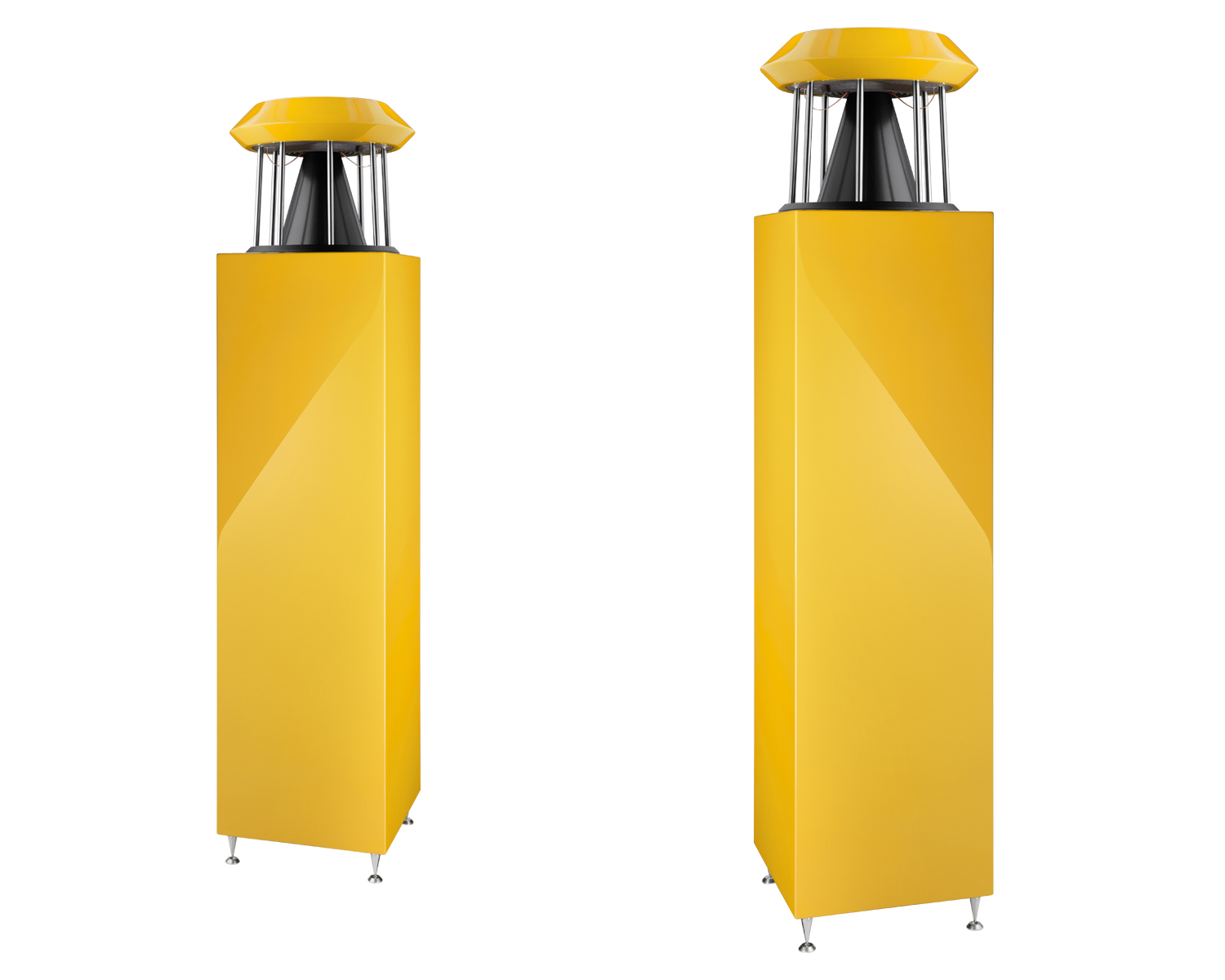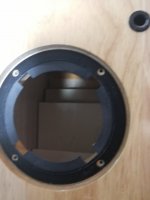at the listening position, anything over 90db is too loud
if you need to party and reach 110db, even a 4” crossed at 400hz would struggle so youd need at least a 6”.id recommend alpair 12p
Indeed it can be. If I were to convey a point though, I'd say you want to control the amount of destructive interference. It's not necessarily a bad thing on it's own..it’s the destructive interaction with the the wide band driver that should be obvious at and around the XO point.
Minor update: mine is Generation 2 (half-expected), 9-11khz a tad less than A5.3 chart, overall frequency response similar to a small-butt vintage alnico "fullrange" (costs about same too). I might try a "plast" waveguide on the dustcap rim. Played all evening as sound gradually improved (and I warmed to it). When pushed above my normal listening level the sound does of course harden up. BR lacks impact, clarity, and depth. Cut ply dividers but ran out of time to make TLonken. Each piece is up to 114x75 so goes through the round hole; takes two to make a wall, nine pieces per speaker (edged with gasket foam, braced here-and-there).Slot 9x114x90.
TLonken 1m planned.
During the just-ended Covid quarantine I used phone with small very-HF EQ boost streaming my own WAV/FLAC, TPA3221 driving Joseph Audio RM7XL (Al cone, soft dome 85dB) which also has a HF dip in disagreement with Stereophile review, enough to affect instrument tonality. So that's what the A5.2 TLonken will be going up against this weekend. I will also left/right compare TLonken with WAW tiny sealed.
I heard the flagship GP at AXPONA, and it had nothing above about 5k in response. Totally dead sounding on top they were. Fellow DIYers present agreed with my assessment.A a pr of German Physics DDD omnidirectional produced quite good sonics in a more or less bigish cubic hotel ballroom at the show.

dave
Not all tweeters are the same. Which tweeters did you find that sounded fake?And when I was young and had excellent hearing, I found tweeters to sound fake.
We don't all hear the same.
TLonken under construction...
BTW from first principles & historical practice I've figured out what F.A.S.T. acronym ought to stand for. Includes some classic 2-ways such as Ref3A, Eggleston, etc. whose main driver ran fullrange without filter.
Fullrange Augmented Straight-Through
BTW from first principles & historical practice I've figured out what F.A.S.T. acronym ought to stand for. Includes some classic 2-ways such as Ref3A, Eggleston, etc. whose main driver ran fullrange without filter.
Fullrange Augmented Straight-Through
Attachments
Last edited:
Satori MD60N-6 2.5" Textile Dome Midrange , I think would make a good choice ,could be crossed over at the 500Hz almost goes up to 15k Hz .

https://hificompass.com/en/reviews/satori-md60n-6
This is one of the cleanest waterfall I’ve ever seen .
https://hificompass.com/en/reviews/satori-md60n-6
This is one of the cleanest waterfall I’ve ever seen .
this must be used at least over 800hz, possibly over 1khzSatori MD60N-6 2.5" Textile Dome Midrange , I think would make a good choice ,could be crossed over at the 500Hz almost goes up to 15k Hz .
View attachment 1124073
https://hificompass.com/en/reviews/satori-md60n-6
This is one of the cleanest waterfall I’ve ever seen .
With an omni the room plays an even more important role in how things soundI heard the flagship GP at AXPONA, and it had nothing above about 5k in response. Totally dead sounding on top they were. Fellow DIYers present agreed with my assessment.
dave
Would the placement of the Omnis be in the middle of the room to sound its best?With an omni the room plays an even more important role in how things sound
dave
Soft dome tweeters, metal dome tweeters, bullet tweeters, ring radiators, piezo tweeters and planar to name but a few.Which tweeters did you find that sounded fake?
That said, I have heard tweeters crossed >5kHz that blended well. Often topping off a big horn or large diameter full-range driver. As I’ve gotten older they bother me less and less.
So basically its not actually the tweeters per say that sounded fake but the fact that they werent integrated/blended well.Soft dome tweeters, metal dome tweeters, bullet tweeters, ring radiators, piezo tweeters and planar to name but a few.
That said, I have heard tweeters crossed >5kHz that blended well. Often topping off a big horn or large diameter full-range driver. As I’ve gotten older they bother me less and less.
Maybe. But I heard a lot of tweeters that people just loved and raved about. In many different designs and price levels. I found them to sound fake, unnatural. Most people called them well implemented. I found them very Hi-Fi and fake. Maybe pleasant, but not realistic or true to life.
Depends on the room and the omni. There are many flavoursWould the placement of the Omnis be in the middle of the room to sound its best?
dave
I briefly tried upfiring "omni" Lowther PM6A (a la Citation X 360 with custom PM6), using hand-wound-and-shaped reflectors made from 0.5mm-thick gasket foam strip. The reflectors were effective, but instead of taming peaky HF as I had hoped (by laying driver flat) it exacerbated the problem because radius output overweighs HF compared to surface area output dominated by LF. (More than the lower-frequency wider dispersion could compensate.) Another problem is very low efficiency. I had to really crank up the power, possibly beyond the 98dB-sensitive (higher at HF) PM6A's safe limit. Finally, there seems to be debate whether prolonged upfiring will "gravitationally" shift the VC zero-position (in a delicate driver).
But I did get stereo imaging and very high frequency.
But I did get stereo imaging and very high frequency.
I went multiway an unusual way. I made a smallish floorstanding open baffle pair, each using an Alpair 12P and a 12PW, with the intention of using the size of the OB as a passive first order highpass. Also intended was using a filter to boost the lower reaches of the 12P a little, by lowpassing the 12PW between 100 and 200 Hz with a fairly shallow sloped filter, to get a gradual slope and flatter response.I have asked that question myself after hearing my lines with 18 pcs of 4 inch Visaton FR10HM with wizzers. I think it is the MUCH large lower frequency 500-2k capacity that gives the remarkable ease and low distortion in the treble that shines through. When you have 18 drivers, doppler is no problem as you cant nearly feel or see the drivers move at still very loud levels.
Backside - and its a big one - dispersion.
//
In little time, I preferred using one or the other driver and the 100 hertz first order highpass on my preamplifier, approximating a 2nd order filter to the satellites combining with the 4th order lowpass on my subwoofer.
While one or the other full range Alpair was preferable with various recordings, I decided to stop changing connections between them and ran the 12PW full range aside from the preamp's highpass, and use the 12P highpassed at 20,000 Hz or so first order.
Given that it's 3 or 4 db more efficient than the 12PW, it's about right for my hearing loss up that high, while not adding sibilance.
It's surprisingly good off axis; I think maybe the relatively small dustcap radiates sound too, improving dispersion at high frequencies.
I tried this more or less on a lark, intending to cut new baffles for some AMT tweeters, planars, or some vintage alnico 2 inch tweeters here.
But it's satisfying as is, and retains the option of returning to a stereo amp per channel crossover option should I wish, or just going with one driver of choice per channel plus sub.
Subjectively, the sound having a little treble extension added to the 12PW sounds much more balanced when used in conjunction with a sub.
I was not expecting this treble dispersion from what's sold as an 8 inch full range driver (small cone though), but there's at least in this case a lot more to the dispersion than taking the diameter of its radiating cone as the measure of the onset of beaming.
Yes, you have a really big "tweeter" there. I'm sure its very good. What (often) happens is that the dustup / wizzer goes "bending wave mode" and thus starts to radiate very broadly i.e. quite the opposite of beaming. Göbeln has a very wide dispersion up top despite its big and flat membrane.
//
//
I find it odd that most tweeters are a forced monopole, and if you want a dipole you either have to find an open-backed one or hack the hardware.Maybe. But I heard a lot of tweeters that people just loved and raved about. In many different designs and price levels. I found them to sound fake, unnatural. Most people called them well implemented. I found them very Hi-Fi and fake. Maybe pleasant, but not realistic or true to life.
When I started playing around with changing amplifier output resistance, eg. by adding resistors in series with speakers, I was struck by how the sound was suddenly cleaner and with less 'hash'. Not sure if hash is the same as a 'hifi' sound, but I hope my experience may stir some curiosity in others.
I remember doing some before/after frequency measurements and, the 'padded' ones with series resistors actually had more peaks and dips, when looking at the non-smoothed details. There wasn't any easily discernible trend though, with more bass or other coarse changes in tonality to bias the results. Yet, the tweeters with 10 or 22 ohms in series just sounded better to my ears, which got me started down the rabbit hole of current drive amplifiers.
Whilst messing around trying to smooth out the mid-range peek in some full range speakers (two car duel cones wired in series), I tried a 1 ohm resistor to reduce damping on the bass, but I found it too dull, so I bypassed the resistor with a 1 uf cap; this gave quite a pleasant sound, I used them like that for a few months untill I tried a contour network that did the job much better. A resistor on the bass driver seems to work well with aperiodic enclosures.
- Home
- Loudspeakers
- Multi-Way
- Are modern fullrange drivers better than tweeters?
